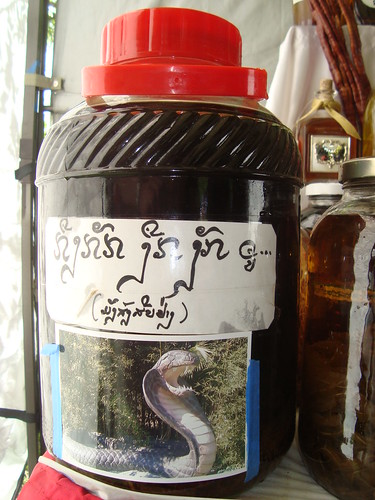We might expect this creature to be between 9.8 to 32 feet in length, with 20 feet the most likely size for a large example. This would be based upon purported sizes for anacondas and the longest size for a king cobra. Meganaja Laoensis would probably have coloration ranging from grey to brown to black, with some form of spots or stripes, possibly white or yellow in coloration. If it has the ability to spit venom, it would most likely be a highly dangerous brew of postsynaptic neurotoxin and necrotizing cytotoxin inducing death within 3 to 5 minutes, aiming for your face and particularly your eyes and nasal cavity. Anticipate permanent blindness, paralysis, and asphyxiation while your cells in the envenomed area proceed to dissolve. Pain and extreme swelling are likely additional symptoms that will be evidence of an encounter. If spitting venom at a victim is not enough it will bite, holding onto you fiercely while it also savagely chews into muscle tissue, injecting additional venom.
This is primarily a nocturnal species that seeks out very large prey for sustenance but primarily found in deep forest and mountain regions. In Laos, 60 to 70% of the countryside is covered in mountains and forest, although current heavy efforts at mining and logging are likely to increase chances of discovering a Meganaja Laoensis within the next decade.
I would speculate that it is like many naja, and therefore oviparous, meaning the female will presumably lay between 5 and 25 eggs in clutch with 10 being the average, hatching between 48 to 70 days depending on environmental conditions. The hatchlings will be between 15 to 20 inches and independent as soon as they emerge from the eggs and possess fully developed venom delivery systems, so they must absolutely be treated like adult versions if encountered.
During the daytime, it may exhibit signs of timidity especially among large numbers of humans and animals but during the night, based upon the behavior of its cousins, Meganaja will be more aggressive and likely to stand its ground, warning you by flaring out its hood before spitting venom.
Superstitious local villagers are likely to attribute medicinal properties to its flesh, venom and other by-products. Such claims should deservedly bet met with extreme skepticism.
Since I'm on a roll, I'll also do a shout-out to the dreaded Megadionae homocipula, the legenday Giant Venus Mantrap of Laos. Note that I am just speculating on the possibility of these entities. But if it turns out there IS one, you saw it here first.


No comments:
Post a Comment